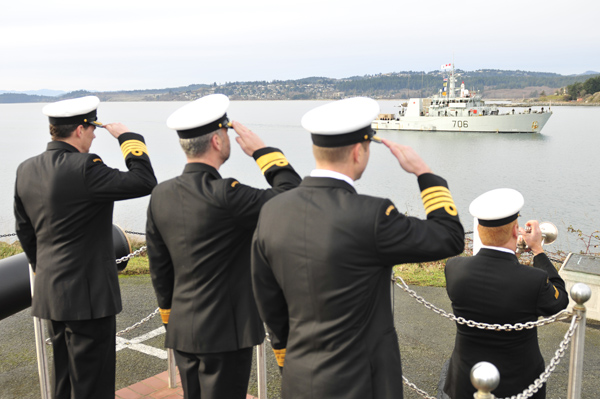Yellowknife and Edmonton showcase their strengths
By Lookout on Dec 23, 2013 with Comments 0

HMCS Yellowknife is welcomed back to CFB Esquimalt by the Admiral after three months at sea with Operation Caribbe.
HMC Ships Edmonton and Yellowknife, along with HMC Submarine Victoria, returned home last Thursday after completing deployments in the Eastern Pacific Ocean, marking the end of a very successful year for Operation Caribbe 2013.
It was late fall when Yellowknife and Edmonton left Esquimalt harbour for what would be a fruitful operation combating transnational organized crime off the Caribbean and Pacific coasts of Central America.
Brimming with anticipation, the two reserve crews sailed away in their Maritime Coastal Defence Vessels Sept. 23 for their three month deployment. The transit was 3,200 nautical miles south to the west coast of Central America. The mission: Operation Caribbe, Canada’s contribution to the international campaign against illicit drug trafficking in that region.
While en route, the ships’ crews completed work-ups tailored to the unique requirements of their upcoming mission. Following a quick stopover in San Diego to pick up United States Coast Guard Law Enforcement Detachments, the MCDVs joined a two-day exercise dubbed North American Maritime Security Initiative (NAMSI) between the Canadian, Mexican, United States Navies and the U.S. Coast Guard. That exercise challenged the Canadian, U.S., and Mexican forces to plan and execute a combined response to a maritime security threat.
Several objectives were met including coordinated planning, seamless information sharing, and command and control during the detection, interdiction and disposition of a vessel engaged in illicit activities.
With training complete, the Canadian MCDVs continued south to the Mexican Naval Base in Ensenada, Mexico. Sailors were introduced to Mexico’s multiple counter-narcotic practices, such as their road search procedures and canine unit, as well as a tour of their Coast Guard vessels and Russian built Mi 17 helicopter.
Each country joined in hospitality celebrations, with Admiral Victor Uribe Arevalo of the Mexican Navy awarding Yellowknife a plaque in commemoration of their involvement in NAMSI. In return, LCdr Brad Henderson, Commanding Officer of Yellowknife, presented a ships plaque to the Ensenada Officer Mess. Edmonton followed into Ensenada later that day and LCdr Blair Brown, Edmonton’s Commanding Officer, presented Admiral Arevalo with a ship’s crest as a token of his appreciation for the hospitality the ship enjoyed in Mexico.
Then Operation Caribbe went into go mode. The ships transited south to their operational area off of Central America. Both vessels witnessed a flurry of activity with multiple hailings and boardings of suspicious vessels while maintaining a constant aggressive patrol in search of northbound narcotic trafficking. Yellowknife and Edmonton were quickly rewarded for their efforts.
During a search on Oct. 25, Edmonton’s law enforcement detachment successfully seized 639kg of cocaine from a suspect vessel and transferred three detainees to a United States Coast Guard unit.
A day later, Yellowknife, under cover of darkness, boarded a suspect vessel associated with a reported drug trafficking case. Despite an intrusive search of the vessel, no drugs were found; it was assessed to have been jettisoned.
Yellowknife’s presence in concert with a patrol aircraft and other military assets, delayed and ultimately disrupted any transfer of cocaine.
The next day, Edmonton boarded another vessel that yielded 468kg of cocaine in eight large bundles, and much like their earlier interdiction, the detainees and contraband were transferred. All three events were conducted in full darkness and facilitated by a Canadian Maritime Patrol Aircraft that detected the suspect vessels.
The policing didn’t end there. On Nov. 3, Edmonton intercepted another suspect vessel, which, once boarded by the law enforcement detachment, tested positive for traces of cocaine. Once the detachment search was completed with no results, it was suspected the vessel had jettisoned their cargo when they ran out of fuel. Three passengers on the vessel were transferred to a local USCG unit under Safety of Life at Sea and the vessel was sunk as a hazard to navigation.
Two days later, Edmonton assisted a United States Navy frigate with a boarding of a suspect vessel, resulting in another Safety of Life at Sea situation.
The final interdiction was on Nov. 14 when Yellowknife boarded and searched an abandoned vessel; it was sunk as a hazard to navigation.
In addition to these specific events during their deployment, Edmonton conducted 12 Right of Approach operations while Yellowknife conducted 10.
Within the first two weeks of being on station, the two MCDVs with support from the CP-140 Aurora prevented 2,057 kg of cocaine, with an assessed street value of $68 million, from reaching land and being distributed to North America.
“This deployment, a first for the west coast Kingston Class vessels, has been a huge success,” said LCdr Henderson. “We have demonstrated that minor warships are more than capable of maintaining counter drug operations for extended periods, far from home. The fact that the successful intercepts were supported by a Canadian Maritime Patrol aircraft demonstrates Canada’s commitment to countering the trafficking of drugs into North America. I am very proud of how well the crew has performed during operations they have never faced before.”
HMC Ships Edmonton and Yellowknife
Filed Under: Top Stories
About the Author:





